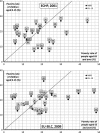Population ageing in Central and Eastern Europe and its demographic and social context
- PMID: 28804408
- PMCID: PMC5547418
- DOI: 10.1007/s10433-012-0217-9
Population ageing in Central and Eastern Europe and its demographic and social context
Abstract
The article focuses on several demographic and socio-economic idiosyncrasies in Central and Eastern Europe, which impact the process of population ageing and intergenerational relations. These include the adverse mortality trends and especially the excess male mortality in certain countries, which exacerbated sex differences in life expectancy beyond anything ever recorded in peace-time population history, the combination of natural population decrease and net emigration, the disordered cohort flows and the shorter generational length. The rapid demographic change in these countries coincided with political, economic and social transformations. The shock of the fall of communism affected differently younger people, who could relatively easily reorganize their life cycles so as to adapt to the changed circumstances, and older persons for whom such reorganization was more difficult, or even impossible. This created the possibility for the opening of an intergenerational rift, as older generations felt being the losers of the transition. The article explores the implications of these idiosyncrasies and social context for living arrangements, kin networks, individual wellbeing and inter-generational relations, and identifies areas where particular challenges are likely to be faced when it comes to policies and programs aimed at older persons.
Keywords: Central and Eastern Europe; Disordered cohort flows; Excess male mortality; Inter-generational relations; Living arrangements; Population ageing; Subjective wellbeing.
Figures






Similar articles
-
Economic development with limited supplies of family labor: Chinese peasant families in balancing demographic and economic requisites.Korea J Popul Dev. 1991 Jul;20(1):47-76. Korea J Popul Dev. 1991. PMID: 12285338
-
Age-specific mortality trends in France and Italy since 1900: period and cohort effects.Eur J Popul. 1987 Nov;3(1):33-60. doi: 10.1007/BF01797091. Eur J Popul. 1987. PMID: 12158949
-
Ageing and intergenerational family ties in Arab countries.East Mediterr Health J. 2016 Feb 1;21(11):835-43. doi: 10.26719/2015.21.11.835. East Mediterr Health J. 2016. PMID: 26857721 Review.
-
Cultural aspects of ageing: gender and inter-generational issues.Soc Sci Med. 1996 Sep;43(5):681-7. doi: 10.1016/0277-9536(96)00112-8. Soc Sci Med. 1996. PMID: 8870132 Review.
-
Health and mortality in Eastern Europe, 1965-85.Communist Econ. 1990;2(3):347-71. doi: 10.1080/14631379008427651. Communist Econ. 1990. PMID: 12316990
Cited by
-
Alcohol Consumption and Longitudinal Trajectories of Physical Functioning in Central and Eastern Europe: A 10-Year Follow-up of HAPIEE Study.J Gerontol A Biol Sci Med Sci. 2016 Aug;71(8):1063-8. doi: 10.1093/gerona/glv233. Epub 2016 Jan 8. J Gerontol A Biol Sci Med Sci. 2016. PMID: 26748094 Free PMC article.
-
How the Labor Market Affects the Self-Perceived Health of Older Workers. The Evidence From Central and Eastern European Countries (CEECs).Front Public Health. 2021 Jul 5;9:655859. doi: 10.3389/fpubh.2021.655859. eCollection 2021. Front Public Health. 2021. PMID: 34291024 Free PMC article.
-
Suicide among older people in relation to their subjective and objective well-being in different European regions.Eur J Ageing. 2013 Oct 23;11(2):131-140. doi: 10.1007/s10433-013-0297-1. eCollection 2014 Jun. Eur J Ageing. 2013. PMID: 28804321 Free PMC article.
-
Identifying Potential Drug-Related Problems Among Geriatric Patients With Use of an Integrated Clinical Decision Support Tool.Front Pharmacol. 2022 Mar 28;13:761787. doi: 10.3389/fphar.2022.761787. eCollection 2022. Front Pharmacol. 2022. PMID: 35418859 Free PMC article.
-
Social networks and cognitive function in older adults: findings from the HAPIEE study.BMC Geriatr. 2021 Oct 18;21(1):570. doi: 10.1186/s12877-021-02531-0. BMC Geriatr. 2021. PMID: 34663241 Free PMC article.
References
-
- Bloom DE, Canning D, Sevilla J (2003) The demographic dividend: a new perspective on the economic consequences of population change. Population Matters Series. Rand, Santa Monica, CA
-
- Botev N (1999) Older persons in countries with economies in transition. In: Population ageing: challenges for policies and programmes in developed and developing countries. pp 85–100. UNFPA and CBGS
-
- Botev N (2008a) “Can policies enhance fertility in Europe?” and questions beyond. Vienna Yearbook of Population Research 2008, pp 29–34
-
- Botev N (2008b) The forgotten parts of the region. In: Civil society forum on ageing. pp 227–231. IMSERSO, Madrid
-
- Carlson E. Concentration of rising Hungarian mortality among manual workers. Sociol Soc Res. 1989;73:119–128.
LinkOut - more resources
Full Text Sources
Medical

